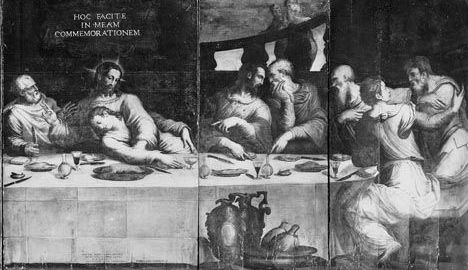Rescue Mission: Saving Vasari’s “Last Supper” 45 Years After a Flood

When the Arno River overflowed in 1966 and flooded Florence, Italy, an art apocalypse nearly took place in that grand Renaissance city. Countless works, including Lorenzo Ghiberti’s Doors of Paradise,Donatello’s Magdalene, anda crucifix by Giovanni Cimabue, sustained serious damage from water and mud. Almost 45 years later, the rescue mission continues as conservation technology advances to a point at which it can finally restore some of these works to their original glory. Thanks to those advances, and to a €300,000 Getty Foundation grant awarded to Florence’s Opificio delle Pietre Dure e Laboratori di Restauro (OPD), Giorgio Vasari’s 1546 The Last Supper (detail shown) will undergo a 3-year resurrection to roll back the damage those rising floodwaters once caused. Vasari, author of the The Lives of the Most Excellent Italian Painters, Sculptors, and Architects, from Cimabue to Our Times and the original conservator of art history through his writing, finds his work the subject of one of the great conservation efforts in art history.
“The painting was under water for 12 hours so the level of damage is terrible. It’s one of the worst cases in conservation history,” said Marco Ciatti, director of the OPD’s panel paintings department. For half a day, the wood panels of Vasari’s 8 by 12 foot painting drank in the Arno’s waters and swelled beyond recognition. When the waters receded, the panels dried out, cracking in the process. Vasari’s painting took a beating from this give and take, resulting in a mess that has saddened and puzzled conservationists for decades, until now.
Necessity has always been the mother of invention in the art conservation business. Conservationists today now tangle with the new demands of keeping 20th century works intact, including Abstract Expressionist works painted using house paints and other exotic products that present new and unique preservation challenges. And, yet, the art of the past continues to puzzle protectors looking to preserve the past. This project will not only draw on the expertise of the older, experienced conservators, but it will become a laboratory in which the next generation of conservators first make their mark. The art history written in the future will in many ways begin with this new project, as it will determine which works will live or die after our generation is gone.
Vasari may only be a footnote in art history today, dwarfed by the Renaissance giants he heralded, but he remains in art history circles a significant, albeit secondary, figure. Saving Vasari’s painting may seem unnecessary, but the people of Florence have vowed to leave no painting behind, no matter how long it takes. The “mud angels” that led the initial postdiluvian conservation in Florence continue to minister to the stricken art of their city. For them, Florence remains an eternal city of eternal art. The financial generosity of The Getty also has helped Florence become a city of eternal hope.





